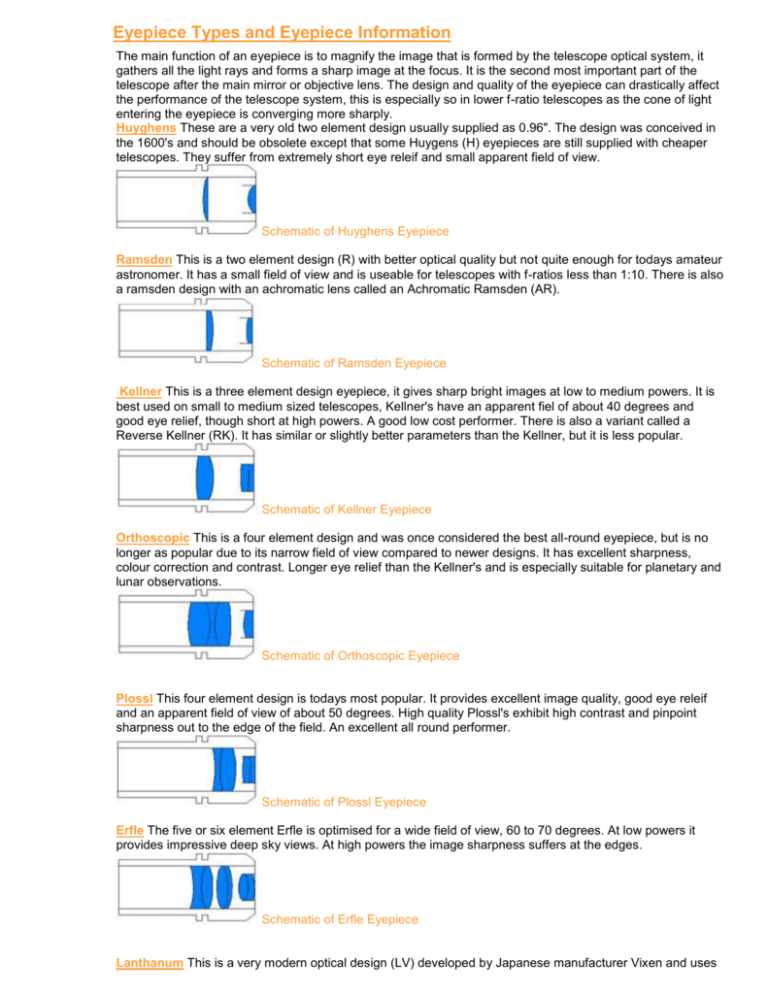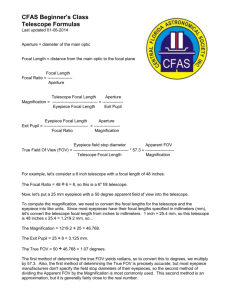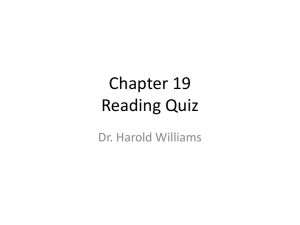Eyepiece Types and Eyepiece Information
advertisement

Eyepiece Types and Eyepiece Information The main function of an eyepiece is to magnify the image that is formed by the telescope optical system, it gathers all the light rays and forms a sharp image at the focus. It is the second most important part of the telescope after the main mirror or objective lens. The design and quality of the eyepiece can drastically affect the performance of the telescope system, this is especially so in lower f-ratio telescopes as the cone of light entering the eyepiece is converging more sharply. Huyghens These are a very old two element design usually supplied as 0.96". The design was conceived in the 1600's and should be obsolete except that some Huygens (H) eyepieces are still supplied with cheaper telescopes. They suffer from extremely short eye releif and small apparent field of view. Schematic of Huyghens Eyepiece Ramsden This is a two element design (R) with better optical quality but not quite enough for todays amateur astronomer. It has a small field of view and is useable for telescopes with f-ratios less than 1:10. There is also a ramsden design with an achromatic lens called an Achromatic Ramsden (AR). Schematic of Ramsden Eyepiece Kellner This is a three element design eyepiece, it gives sharp bright images at low to medium powers. It is best used on small to medium sized telescopes, Kellner's have an apparent fiel of about 40 degrees and good eye relief, though short at high powers. A good low cost performer. There is also a variant called a Reverse Kellner (RK). It has similar or slightly better parameters than the Kellner, but it is less popular. Schematic of Kellner Eyepiece Orthoscopic This is a four element design and was once considered the best all-round eyepiece, but is no longer as popular due to its narrow field of view compared to newer designs. It has excellent sharpness, colour correction and contrast. Longer eye relief than the Kellner's and is especially suitable for planetary and lunar observations. Schematic of Orthoscopic Eyepiece Plossl This four element design is todays most popular. It provides excellent image quality, good eye releif and an apparent field of view of about 50 degrees. High quality Plossl's exhibit high contrast and pinpoint sharpness out to the edge of the field. An excellent all round performer. Schematic of Plossl Eyepiece Erfle The five or six element Erfle is optimised for a wide field of view, 60 to 70 degrees. At low powers it provides impressive deep sky views. At high powers the image sharpness suffers at the edges. Schematic of Erfle Eyepiece Lanthanum This is a very modern optical design (LV) developed by Japanese manufacturer Vixen and uses Lanthunum optical glass. It has extra long eye relief and excellent field of view. It is recommended for observations at medium to high power. Ultra-Wide These have variuos designs incorporating six to eight elements and have apparent fields of up to 85 degrees, its so wide you have to move your eye around to take in the whole panorama. Light transmission is slightly diminished but other wise images are of a very high quality. Illuminated-Reticle Eyepieces These eyepieces have either etched crosshaires or other reticle grid patterns at the focal plane that can be illuminated so that they can be seen in the dark. These eyepieces are usually designed with a red LED as the light source powered by a small watch battery and the intensity of the red LED can be changed by a small potentiometer (control). These components are all incorporated in the design of the eyepiece. This type of eyepiece is ideally suited for guiding long exposures in astrophotography. Barrel Size Eyepieces basically come in three standard barrel sizes or diameters, 0.965", 1.25" and 2". The smaller 0.965" are usually found on cheaper department store style telescopes and should be avoided if possible. Most amateur telescopes are equipped with 1.25" barrels. The larger 2" models are usually found on the higher end telescopes, and offer increased field of views and brighter images. Magnification and Focal Length In using a telescope you will have noticed that usually low power eyepieces will give you small bright clear images while high power eyepieces can give you big dull blurred images. There are two main reasons for this. The first is that you are trying to spread the same amount of light over a larger area with high power eyepieces, this produces your duller images. Secondly your telescope can only pick up a certain amount of fine detail, so if you are trying to magnify beyond the capabilities of the telescope you will just end up making the images blurry. This is called empty magnification. To calculate the power a particular eyepiece will provide just use the simple formula below. Telescope Focal Length (mm) Magnification( power) = _________________________ Eyepiece Focal Length (mm) For example, a telescope with a 2000mm Focal Length using a 20mm eyepiece will give 100x Magnification (2000y20)=100. Commonly available eyepieces have focal lengths of between 6mm and 40mm. The eyepiece barrel diameter limits the practical focal lengths that can be used. A 32mm Plossl or 40mm Kellner uses the entire diameter of a 1.25" barrel, a longer focal length will not cover a wider field. On the other hand, in most eyepiece designs, short focal lengths (less than 6mm) suffer from impracticably small lenses, which require you to position your eye impossibly close to the lens. If you need focal lengths greater than 40mm you will probably need to use 2" eyepiece barrels and eyepieces. Practical Focal Lengths for Eyepieces To determine what eyepieces you need to get powers in a particular range with your telescope, you can use the formulas on this page, or you can take a shortcut by using the following table: Power Range Eyepiece (f/4 Telescope) Eyepiece (f/8 Telescope) Eyepiece (f/10 Telescope) Eyepiece (f/15 Telescope) VERY LOW 16 - 28mm 32 - 56mm 40 - 70mm* 60 - 105mm* LOW 8 - 16mm 16 - 32mm 20 - 40mm 30 - 60mm MEDIUM 4 - 8 mm 8 - 16mm 10 - 20mm 15 - 30mm HIGH 2.8 - 4mm* 6 - 8mm 7 - 10mm 10 - 15mm VERY HIGH 2.0 - 2.8mm* 4 - 6mm 5 - 7mm 7 - 10mm *Eyepieces in these ranges are not normally practical. Exit Pupil versus Power The magnifications that a telescope will perform well are dictated by its aperture. A bigger telescope collects more light and gathers a broader wavefront, giving sharper images. A useful way of classifying power is in terms of "power per inch" of aperture. For example 80x on an 8" aperture telescope is 10 power per inch. Another way is to go by the size of the exit pupil (the bundle of light rays coming out of the eyepiece). Exit pupil size in inches is the reciprocal of power per inch. However exit pupil is more commonly calculated in millimetres using these formulas. Telescope Aperture in mm Exit Pupil Size (mm) = _______________________ Telescope Magnification OR Eyepiece Focal Length in mm EXIT Pupil Size (mm) = __________________________ Telescope Focal Ratio The exit pupil must be smaller than the pupil of your eye otherwise light rays will be wasted by not making it into the pupil of your eyes. Young peoples fully dark adapted eyes may have 7mm wide pupils. Unfortunately as you get older the diameter decreases. For middle aged adults the pupil diameter will be more like 5mm. At the other end of the scale, at magnification that yield an exit pupil of 0.5 to 1mm, empty magnification begins to set in, depending on the quality of your telescope and your eyes. Here we see that this much magnification starts to degrade the image you see. Below is a table comparing various powers. Power Range Exit Pupil Size Power Per Inch What It's Used For VERY LOW 4.0 - 7.0mm 3 - 6x Wide-field views of deep-sky objects under dark skies. LOW 2.0 - 4.0mm 6 - 12x General viewing; finding objects; most deep-sky observing. MEDIUM 1.0 - 2.0mm 12 - 25x Moon, planets, more compact deep-sky objects, wide double stars. HIGH 0.7 - 1.0mm 25 - 35x Moon and planets (in steady air), double stars, compact clusters. VERY HIGH 0.5 - 0.7mm 35 - 50x Planets and close double stars in very steady air. Eye Relief The distance between the lens of an eyepiece and the point behind the eyepiece where all the light rays of the exit pupil come to a focus and the image is formed. This is where your eye should be positioned to see the full field of view of the eyepiece. If you must wear glasses because of astigmatism, you'll need at least 15mm of eye relief if you want to see the full field of view with your glasses on. Apparent Field of View The optical design of eyepieces also influences the size of the field of view that you can see. An eyepieces apparent field of view is an angular diameter in degrees(L), of the circle of light the eye sees. Most eyepieces have an apparent field of view of about 40L to 50L. True Field of View The true field of view is the area of sky seen through the eyepiece when its is attached to the telescope. The true field can be approximated by using the following formula. APPARENT FIELD TRUE FIELD = ________________ MAGNIFICATION For example if you have a 152mm Maksutov-Cassegrain with a focal length of 2000mm and a 50 degree apparent field 20mm eyepiece. The magnification would be (2000mm y 20mm) = 100x. The true filed would be 50 y 100, or 0.5L, which is about the same apparent diameter as the full moon. Some of the older eyepieces cover only about 30L, while some of the newer types may cover 60L or more, however 40L to 50L should be sufficient for most observers. Parfocal Eyepieces These are eyepieces that can be interchanged without the need to re-focus your telescope. This is desirable but not necessary while switching eyepieces when looking at the same object. Usually eyepieces of the same design from the same manufacturer are parfocal, but the same design from different manufacturers will likely not be parfocal. How Many Eyepieces Do You Need It is best to have at least two good eyepieces to start with and then add on from there. For example, for an f/10 telescope, a 25mm and a 9mm eyepiece will make a good starter set; you can add something around 15mm and perhaps 6mm next. Avoid the temptation to go all the way to the limits (very low and very high) until after you have explored the middle ranges of magnification. When you have several different eyepieces available, you stand a better chance of obtaining the optimal power for the particular object you are observing, given the sky conditions at the time. Usually, you will want to start out with low power (i.e., long eyepiece focal length, such as 25mm or 30mm) to get the object in the field of view of the telescope. Then you can try a slightly higher-power (shorter focal length, maybe 18mm or 15mm) eyepiece and see if the image looks any better. If it does, swap in an even higher-power eyepiece, etc., until you hit the optimum where image brightness, image scale, and the amount of visible detail combine to form the most pleasing view. You can also use a 2x barlow lens to boost the power (or reduce the effective focal length) of any eyepiece by a factor of two. Thus, instead of a 3mm eyepiece, you can use a 6mm eyepiece with a 2x barlow and get the same magnification. By using a barlow lens you can get away with having fewer eyepieces in your collection. To gain the maximum benefit from the barlow, choose eyepiece focal lengths that are not multiples of each other. In other words, if you have eyepieces of 25mm, 12.5mm, and 6mm — multiples of 2 — then a 2x barlow won't provide much in the way of additional magnifications. But if your eyepieces are 25mm, 15mm, and 10mm, then use of the 2x barlow with each, respectively, will provide 12.5mm, 7.5mm, and 5mm effective focal lengths — just like having three additional (and different!) eyepieces.







